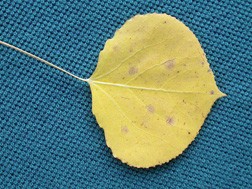The Mighty Trembling Aspen
- Share
- Tweet
- Pin
- Share
I wonder how many people in Wisconsin could answer this question correctly: “Which tree has the widest distribution of all trees on the North American continent?” A seven-inch-long twig from one of these wonderful trees rests on the table before me and has been the object of my close study, using a hand lens, for the past hour.
Thirty one- to two-inch leaves dangle loosely on approximately equal length flat stems, or petioles (PET-e-oles). When I grasp the broken end of the twig between my thumb and forefinger and twirl it back and forth the roundish leaves produce a papery quaking sound as they brush against one another. This well-loved “music” has often been described as the trembling or rustling conversation of these common trees. You’ve guessed it, the Trembling Aspen.

The top leaves are Large-toothed Aspen and bottom are Small-toothed Aspen.
Here is something you may wish to do this fall before the Aspen leaves are shed. On a windy day locate an Aspen that is at least six or more inches in diameter. Place your head so that one of your ears is pressed tightly against the trunk and you will be amazed at how well you can hear the rustling of the leaves – somewhat like water flowing through the wood.
I especially like this name because it speaks of its scientific name, Populous tremuloides (POP-you-lus trem-u-low-EYE-dees). Populus is the classical Latin name of this large group of related trees, which also includes the widespread Eastern Cottonwood, while the tremulous action of its leaves brought about its species name. I’m sure that more people refer to this tree as the Quaking Aspen, or even Popple, a colloquial name commonly used, especially by loggers. Golden Aspen and Mountain Aspen are names presumably of western origin. I’ve had people from western states make the claim that nowhere else in the world are Aspens as richly golden in fall as in their home regions. By the way, the huge Eastern Cottonwood in Institute is Door County’s largest tree.
The statement is made in Trees of America, published by Outdoor World, that people of the Empire Mining District of Clear Creek County, Colorado, claim that a new gold prospecting technique is based upon Aspen leaves and pine needles. Chemical tests of the humus-rich soil show traces of gold, indicating that the gold is brought up from soil through the roots, reaches the leaves and is finally returned to the ground when the leaves are shed. Maybe those Westerners are right after all!
Several years ago we were lucky to be able to drive the famous Tioga Road (Highway 120), from west to east in late October through the central part of Yosemite National Park just before that awesomely scenic road was closed for the winter. We drove through the Tioga Pass, joined up with Highway 395 and headed south down the Owens Valley to Bishop, California, to see the Bristlecone Pines in the nearby White Mountains.

Leaf of the Trembling Small-toothed or Quaking Aspen, or Popple.
There were several scenic stops along the way where we thrilled to the thousands of shimmering, golden Plains Cottonwoods at lower altitudes bordering the Owens River and great expanses of Trembling Aspens extending as far up the mountainsides as growing conditions allowed. It was then that we could fully agree with our western friends, who for years have been bragging about their beloved Cottonwoods and Aspens being more golden than ours in fall.
One of the reasons many people enjoy the Trembling Aspens is because they retain their leaves so late into the fall. Once the leaves of both the Trembling and the Large-toothed Aspens have fallen, the trees can be easily identified by their buds. Those on the Trembling are dark and shiny while the buds on the Large-toothed (P. grandidentata—pronounced gran-di-ten-TAY-ta) appear frosted with tiny hairs.
Many people look down upon the lowly Aspens as just plain good-for-nothing; however, don’t tell that to the beavers. The bark, especially the nutritious inner bark, makes up most of their winter food, and the twigs, branches and trunks are also used in the construction of their lodges and dams. Ruffed Grouse, Snowshoe Hares, porcupines, moose and deer all depend upon either the buds, bark, or leaves for food.
Interestingly, the Ruffed Grouse prefer the buds on the male Aspens that are between 30 to 40 years old. Look at distribution maps of Trembling Aspen and Ruffed Grouse in North America; you will find the maps to be virtually the same.
One of my dad’s fishing cronies of years ago, Clem Cherveny, built a beautiful little weekend vacation and hunting cabin north of Mountain, Wis., and paneled it with planed and varnished Trembling Aspen boards. The thing that impressed me was the beautiful satiny-white color of the finished walls. Ordinarily Aspen wood ends up at the paper mills, where a considerable amount is transformed into cardboard, magazine paper or newsprint. Wooden matches, boxes and crates, along with excelsior, are also made from this light and plentiful wood.
One of the great features of Aspens is their role as nurse trees in the natural succession of plants. One can accurately call them pioneer trees as they spring up quickly along shores, in burned-out areas and where the soil has been disturbed and depleted. They demand open sunlight as they grow very rapidly. Their crowns form an intermingled canopy, providing temporary shelter for other trees such as Pines. Eventually the Aspens give way to the Pines, Oaks or Maples which will predominate in what is referred to as the climax forest.

The slightest breeze causes the Trembling Aspen leaves to twist in all directions.
The trembling action of the Aspen leaves speeds up the evaporation, or transpiration, of water while dissolved minerals carried up from the roots are retained by the leaves and are now made use of in the manufacture of food through photosynthesis.
An overlooked delight in the study of trees comes after the leaves have fallen. Their points of attachment to the trees, indicated by what are referred to as leaf scars, now sealed with a thin layer of corky cells, frequently remind me of funny little faces. They are located just below the winter buds and in reality are cross-sections of the leaf stems. The leaf scars of each species of tree are generally quite uniform, heart-shaped on some, oval or triangular on others. The tiny series of dots making up the eyes and mouth of the whimsical face are where the vascular bundles, or tubes, broke off and through which flowed the sap to and from the leaves.
Trembling Aspens may not reach the value of Maples, Oaks and Walnuts as lumber trees, but fill extremely important niches in wild animal food chains as well as natural succession. I look at the number of periodical magazines and books in our library, then multiply that by millions to represent other people like us and flatly admit, the Trembling Aspen is the most important tree in our lives!


